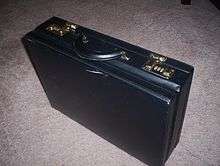Briefcase

A briefcase is a narrow hard-sided box-shaped bag or case used mainly for carrying papers and other documents and equipped with a handle. Lawyers commonly use briefcases to carry briefs to present to a court, hence the name. Businesspeople and other professionals also use briefcases to carry usually important papers, and in more recent times electronic devices such as laptop computers and tablets.
Briefcases are descendants of the limp satchel used in the fourteenth century for carrying money and valuables. It was called a "budget", derived from the Latin word "bulga" or Irish word "bolg", both meaning leather bag (the Irish also means 'stomach'), and also the source of the financial term "budget".
Godillot of Paris was the first to use a hinged iron frame on a carpet bag in 1826. There then followed the Gladstone bag and the Rosebery, an oval-top bag. Eventually these became the modern metal-framed briefcase. The first of what is known as the modern rectangular briefcase is said to have been invented in the late 1850s. In 2014 the global business bag market was $9.4 billion.[1]
Types
- A portfolio is a handleless case for carrying in the hand or under the arm.
- A folio case is a portfolio with a retractable handle.
- An attaché case is a box-style case made of leather (occasionally aluminium), scrunched over a hinged frame that opens into two compartments. It was traditionally carried by an attaché, a diplomatic officer attached to an embassy or consulate officially assigned to serve in a particular capacity (e.g., cultural attaché; military attaché). In recent years, leather pouches (usually slightly larger than a sheet of A4 paper) with a zipper sealed compartment have been referred to as attachés or poche document holders.
See also
References
- ↑ Bain, Mark (25 March 2015). "The story behind the red box that Lee Kuan Yew carried everywhere". Quartz (publication). Retrieved 25 March 2015.
External links
| Wikimedia Commons has media related to Briefcases. |